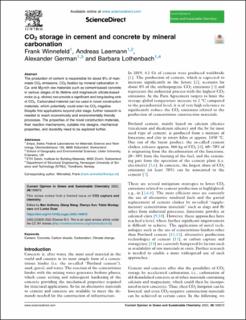| dc.contributor.author | Winnefeld, Frank | |
| dc.contributor.author | Leemann, Andreas | |
| dc.contributor.author | German, Alexander | |
| dc.contributor.author | Lothenbach, Barbara | |
| dc.date.accessioned | 2023-03-30T06:45:09Z | |
| dc.date.available | 2023-03-30T06:45:09Z | |
| dc.date.created | 2023-03-24T10:53:13Z | |
| dc.date.issued | 2022 | |
| dc.identifier.uri | https://hdl.handle.net/11250/3061013 | |
| dc.description.abstract | The production of cement is responsible for about 8% of man-made CO2 emissions. CO2 fixation by mineral carbonation in Ca- and Mg-rich raw materials such as cement-based concrete in various stages of its lifetime and magnesium silicate-based rocks (e.g. olivine) can provide a significant and long-lasting sink of CO2. Carbonated material can be used in novel construction materials, which potentially could even be CO2 negative. Despite first applications beyond pilot stage, further research is needed to reach economically and environmentally friendly processes. The properties of the novel construction materials, their reaction mechanisms, suitable mix designs, mechanical properties, and durability need to be explored further. | en_US |
| dc.language.iso | eng | en_US |
| dc.publisher | Elsevier | en_US |
| dc.rights | Navngivelse 4.0 Internasjonal | * |
| dc.rights.uri | http://creativecommons.org/licenses/by/4.0/deed.no | * |
| dc.title | CO2 storage in cement and concrete by mineral carbonation | en_US |
| dc.title.alternative | CO2 storage in cement and concrete by mineral carbonation | en_US |
| dc.type | Peer reviewed | en_US |
| dc.type | Journal article | en_US |
| dc.description.version | publishedVersion | en_US |
| dc.source.journal | Current Opinion in Green and Sustainable Chemistry | en_US |
| dc.identifier.doi | 10.1016/j.cogsc.2022.100672 | |
| dc.identifier.cristin | 2136643 | |
| cristin.ispublished | true | |
| cristin.fulltext | original | |
| cristin.qualitycode | 1 | |

